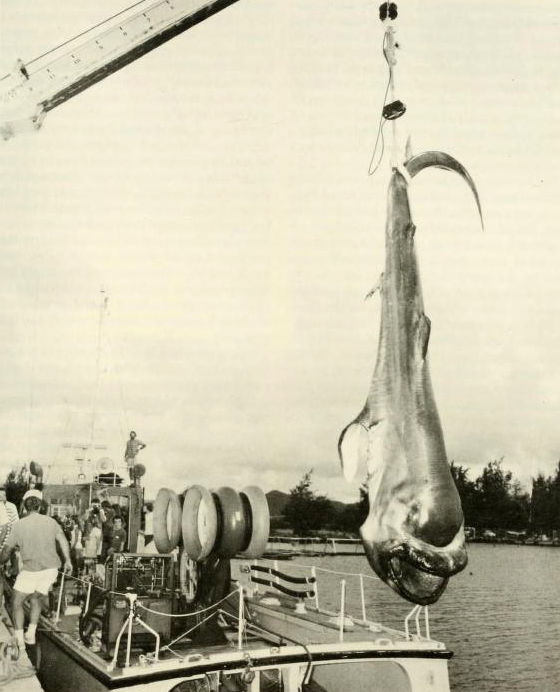PHOTO INFORMATION: A megamouth shark shows its meaty chops off the coast of California. Credit: © Bruce Rasner, Rotman/NPL
The aptly named megamouth shark looks every bit the monstrous man-eater. This enigmatic shark typically grows over 20 feet (4 meters) long and has 50 rows of teeth lining massive, all-swallowing jaws. And those jaws are huge! In fact, the shark’s scientific name, Megachasma pelagios, means giant cavern of the open sea. But there is no reason to fear being swallowed whole by this monster of the deep. Megamouth sharks are filter feeders like basking sharks and whale sharks. They don’t attack large prey, but instead swim with their enormous mouths agape, sucking in shrimplike krill and other tiny organisms that make up ocean plankton.

Sailors accidentally snared this megamouth shark near Hawaii in 1976. Credit: U.S. Navy
Remarkably, before 1976, no one even knew the megamouth shark existed. That year, a United States Navy ship off the north coast of Oahu in the Hawaiian Islands hauled up the 14 foot- (4.3 meter-) long specimen seen in the photograph above after the shark became tangled in the rigging of the ship’s anchor. No one had ever seen or heard of such an odd shark before. The sailors knew enough to call local marine biologists, who arrived to examine this strange and massive fish. The biologists quickly determined it was a shark that had yet to be described.
It seems impossible that such an enormous creature could remain unknown to the modern world. But even today, despite its great size, the megamouth shark remains one of the world’s most rarely seen sharks. A second specimen was not seen until one was caught in 1984. However, megamouth sharks have since been caught or sighted elsewhere in thePacific, as well as in the Atlantic and Indian oceans, indicating it is a widespread species. Still, there have been fewer than 100 sightings or captured specimens since the shark was first discovered. In contrast, there have been many more sightings of the legendary Bigfoot and theprobably imaginary Loch Ness Monster!
Conservation scientists do not have enough information on this fascinating fish to determine if it is endangered or common. The lack of sightings is likely due in part to the fact that the megamouth lurks at great depths during the day and only comes up to shallow levels to feed at night. One can only wonder about what other giant monsters lurk in the deep sea!
View more Behind the Headline stories in World Book Online!
When you need fast, reliable information for homework, reports, or just a lingering question, World Book Online is the place to go.
- A colorful, approachable look and feel, designed for kids, and articles written at your student's level
- Easy access on smartphones and tablets
- Five complete databases for multiple research levels
- Illustrations, maps, audio files, videos, eBooks, primary source documents, and more
Learn More | Buy Now